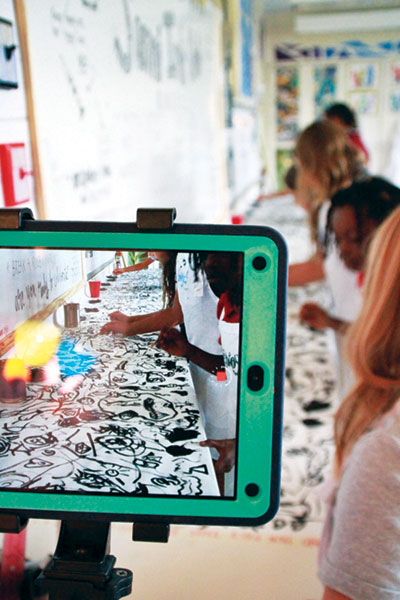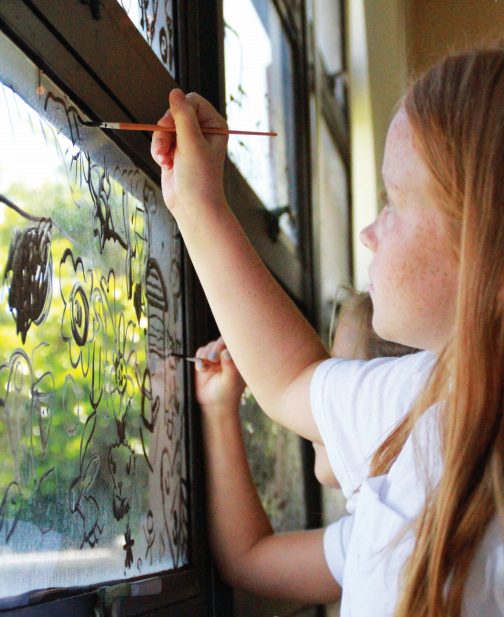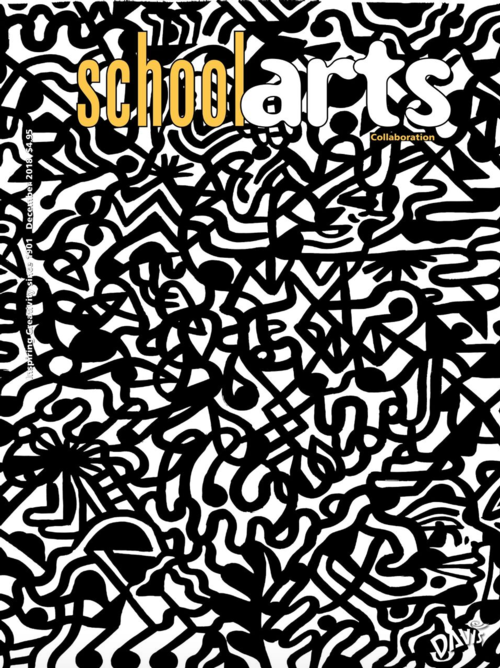 |
| A tablet or smart phone is the perfect tool for documenting a class-wide collaborative drawing session. |
Ink Club Origins
This collaborative participatory art event was originally dubbed the Sumi Ink Club by Sara Rara and Luke Fischbeck, the artist team who invented the project. Sara and Luke created a set of simple rules and strategies for starting and supporting this group drawing experience: (1) Limit the materials to black sumi ink and brushes. (2) Create images that others can add to. (3) Do not add words or names to the drawing. (4) Keep moving around the drawing. (5) Add to what others have drawn.
Sumi Ink Club meetings can be hosted anywhere, by anyone. Having previously attended one of Sara and Luke’s workshops inspired me to set up a similar group drawing experience for students to collaboratively kick off each school year.
Introducing Collaboration
Creating a safe space for collaboration in the artroom is essential. If students feel judged by their creations or judge others, they cannot successfully collaborate on the group drawing. Students must trust in themselves and their fellow artists. I have students work together in teams at large tables to build a collaborative classroom community, facilitating exercises such as turn-and-talk and mind mapping to gauge their prior knowledge of collaboration.
From there we dive into the numerous ways collaboration is used in art before introducing the media—sumi ink. I gauge students’ knowledge of sumi ink and its properties before revealing the kind we will be using, how and where it’s made, and how we’ll be using it. The collaborative and creative process is an engaging way to get to know my students while teaching and practicing artistic procedures.
 |
| Students work on a variety of surfaces, including windows, during their Sumi Ink Club session. |
The Process
Before commencing a Sumi Ink Club session, I encourage students to put their artist thinking caps on by having them literally stop to put on invisible caps. Warmup exercises, such as the exquisite corpse drawing activity, help get students in the right mindset for this large-scale collaboration. Even just beginning with a circle and having students think of what they could add to the shape to create something new starts a collaborative conversation. Showing how students come up with entirely different ideas, stemming from the same original shape, promotes diversity in their thinking and artwork. I encourage them to see that they all possess valuable ideas to contribute to the group drawing.
Simple Materials, Simple Rules
My favorite part about this style of collaboration is that it requires only simple materials and can be done anywhere. We have worked on windows, walls, tables, paper, and even clothing. Students begin to understand the meaning and value of collaboration with the simple rules, “no words, no names.” In preparation, I question my students about ownership—if they all work on something together, who does it belong to? We discuss how it equally belongs to each student who contributed.
The Results
Observing and working alongside students while Sumi Ink Club is in session is one of my favorite ways to start the school year. The process and growth that takes place throughout the day as classes come and go is astonishing. Students take pride in sharing time-lapsed videos of their Sumi Ink Club sessions with their teachers, friends, and family. Students’ ability to share what they learned is one of the simplest assessment methods. When hosting Sumi Ink Club sessions at school events (such as open house and art showcases), I can step back and watch students teach their families, other students, and teachers alike how to collaborate on group drawings.
Students love seeing their Sumi Ink Club drawings line the hallways, serve as bulletin board backdrops, or even on the dress their teacher is wearing to school that day. The Sumi Ink Club connects my school community in ways individual projects couldn’t possibly. All it takes is a bottle of ink and some brushes.
Kelsi Quicksall is an art teacher at Osceola Elementary School in Ormond Beach, Florida.kequicks@volusia.k12.fl.us Twitter/ Instagram: @kelsiquicksall
NATIONAL STANDARD
Creating: Conceiving and developing new artistic ideas and work.
WEB LINK
Sumi Ink Club
View this article in the digital edition.




